Sebastopol Hills : Russian River Valley’s Southernmost Pearl for Pinot Noir
Most visitors to the Russian River Valley congregate in three of the seven neighborhood sub regions of the
Russian River Valley including the Middle Reach, the Santa Rosa Plain and the Laguna Ridge, drawn by the
concentration of notable wineries in these areas. Less widely recognized among visitors is that many of these
wineries reach beyond their own neighborhood to produce Pinot Noir and Chardonnay from the other four main
Russian River Valley sub regions including the Sebastopol Hills, Green Valley, Freestone and Windsor Hills.
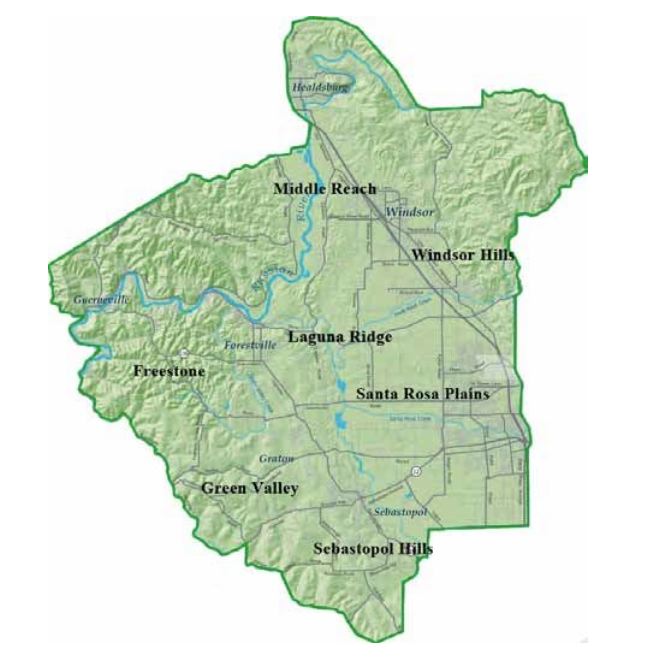
When the Russian River Valley appellation was established in 1983, the amount of Pinot Noir acreage was very
small, and the notion that Pinot Noir made from grapes grown in the Russian River Valley expressed different
nuances depending on where they were grown within the vast Russian River Valley appellation was not yet
realized. As vineyard acreage increased, names for the sub regions assumed common usage. The Middle
Reach was the area along the Russian River south of Healdsburg; the Santa Rosa Plain was a broad flood
plane that once was the Laguna de Santa Rosa, a series of freshwater lakes that drained the valley from Cotati
north to the Russian River; Green Valley became its own appellation also in 1983 as a very cool, foggy sub region in the southwest corner of the Russian River Valley; and the Laguna Ridge was a north to south line of hills situated between the Santa Rosa Plain to the East and Green Valley to the West.
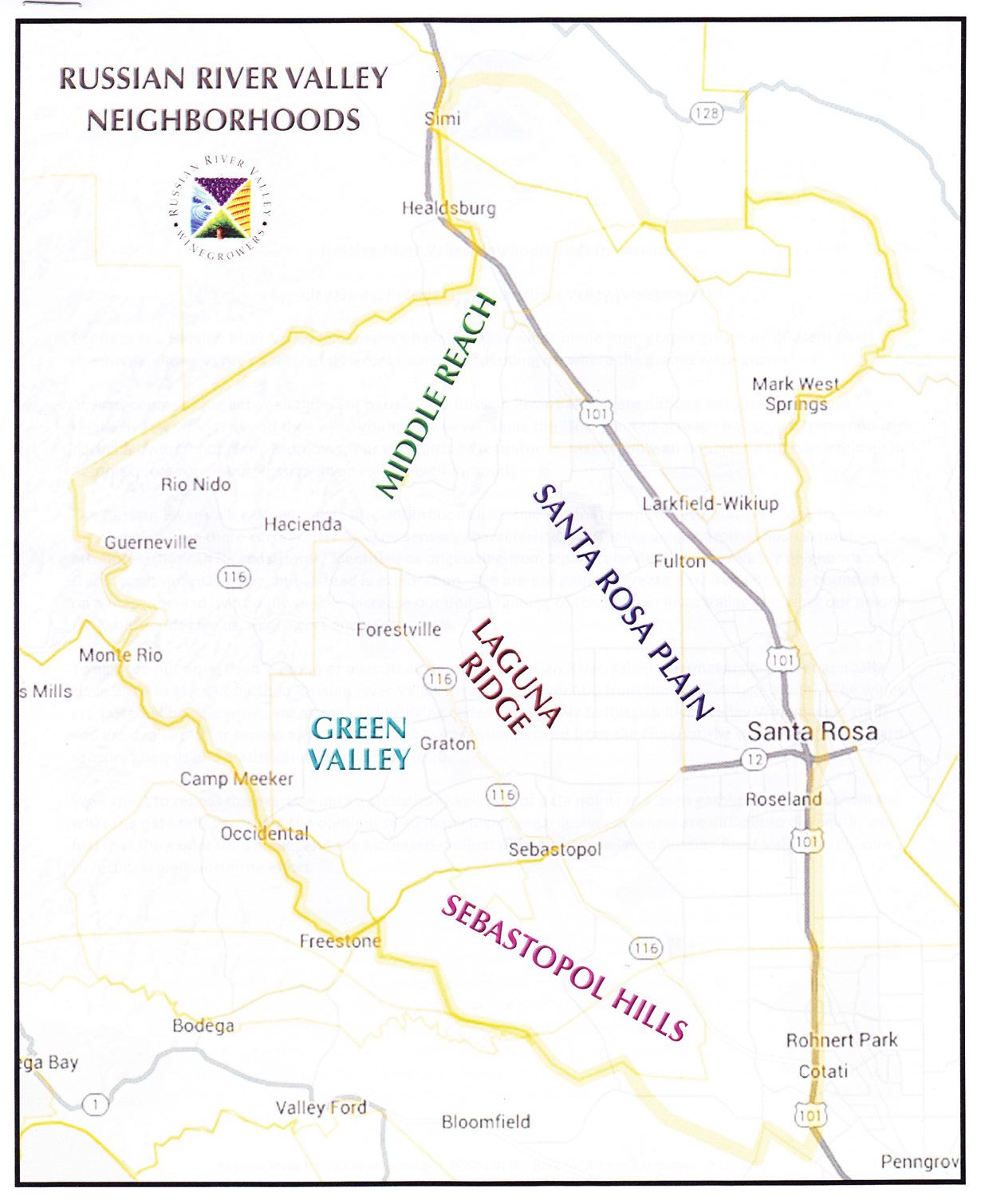
With the expansion of the Russian River Valley appellation in October of 2005, Sebastopol Hills was added as
a sub region, and the neighborhoods of Freestone and Windsor Hills have been identified. These sub regions
are not determined to receive an appellation designation, but rather represent different neighborhoods with
distinctive microclimates and characteristic fruit profiles analogous to the villages of the Cote d’Or. The wines
from each sub region carry an overall defining character of the Russian River Valley appellation as a whole, but
each sub region offers variations on that theme, particularly for Pinot Noir, since the grape is transparent and a
site can be tasted through the wine.
In 2014, the Russian River Valley Winegrowers Association organized a Neighborhood Initiative and Tasting
Panel to determine if it was possible to identify what particular sub region Russian River Valley Pinot Noir came
from. In this ongoing research study, Russian River Valley Pinot Noir is being evaluated for certain sensory
characteristics derived from the grapes (linking them to a sub region) rather than the winemaking. Over a period
of many years it is hoped that patterns will emerge to define the various neighborhoods by the similarities
expressed in the wines.
One particular sub region of the Russian River Valley began to emerge from the mid 1990s as a “pearl” of the
appellation because of the consistent quality of the Pinot Noir originating there and the realization among
growers that this is one of the few promised lands for Pinot Noir in California. Located south of the small town
of Sebastopol, the Sebastopol Hills has been described by John Winthrop Haeger as follows: “A triangular land
of mostly northeast and southwest oriented ridges on the lee side of a transverse ridge that separates the
Russian River Valley from the Petaluma Gap.” The map below from a West of West event shows the outline of
the Petaluma Gap region, proposed Petaluma Gap appellation (that overlaps the Sebastopol Hills), and the
proximity of the Sebastopol Hills.
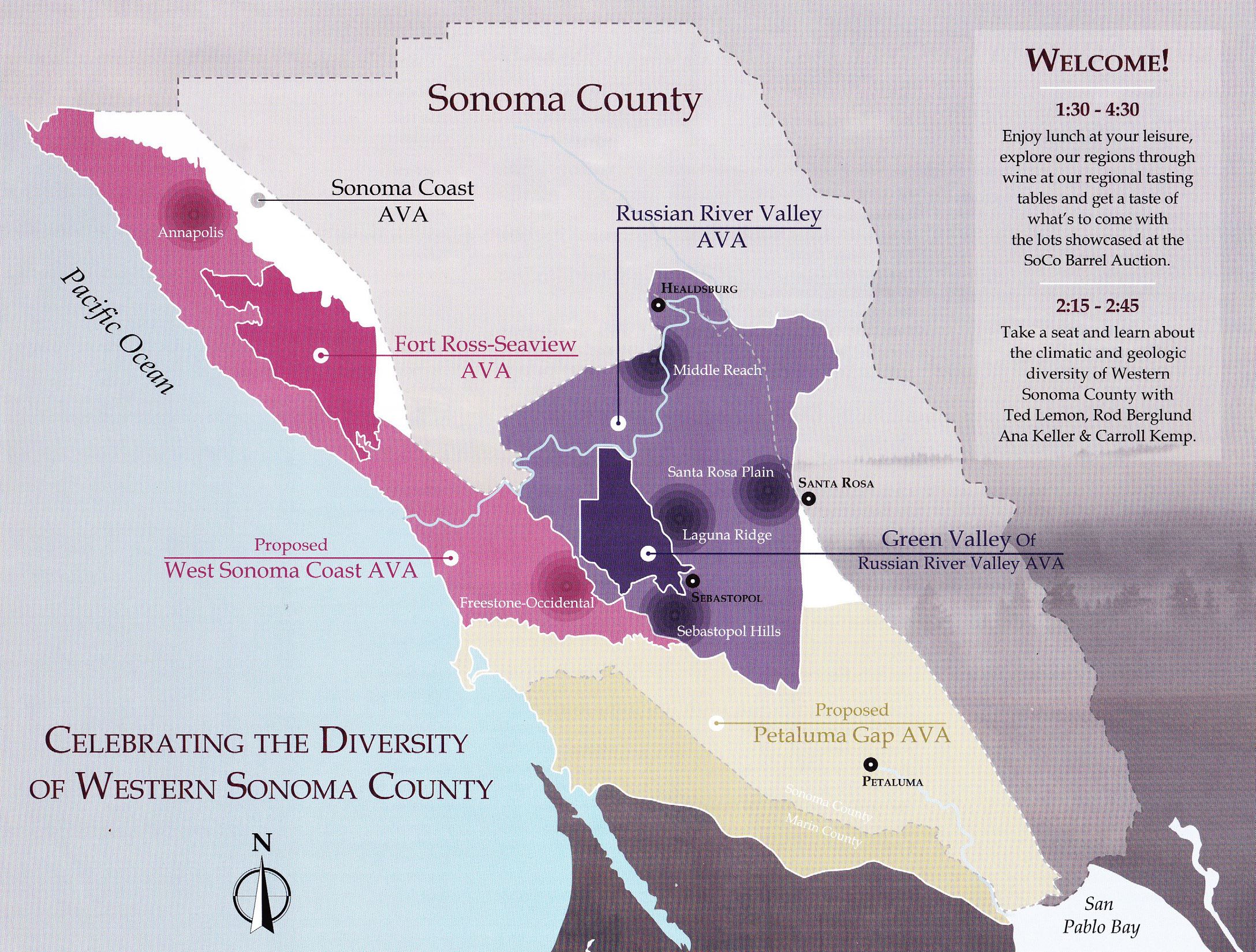
Historically, Sebastopol Hills was an area dedicated solely to Gravenstein apple growing, but apple orchards
have now been replaced by vineyards. According to John Winthrop Haeger (http://www.sfgate.com/wine/article/Sebastopol-s-hilly-new-haven-for-Pinot-Noir-3197929.php), the first tiny vineyard in the sub region, barely three-quarters
of an acre, was planted to Pinot Noir, Chardonnay, Gewurztraminer and field blends in 1972 by a
professor at Santa Rosa Junior College as a backyard project. New owners later renovated the 1972 vineyard,
located near the intersection of Burnside and Sexton roads, and converted it to Pinot Noir.
I spoke with apple grower Randy Peters who was most likely the first to exploit the Sebastopol Hills sub region
for premium winegrowing. He had been leasing half of his father-in-law Tom Mukaida’s apple orchard
beginning in 1976. When he removed some old apple trees, he planted 2 acres of Chardonnay in 1984 that
became Peters Vineyard. In 1986 he added Pinot Noir, initially planting Pommard and Wadenswil, the only
Pinot Noir clones available at the time, and followed with additional plantings including Pommard, Dijon 115
and 777 at two-year intervals until he reached 36 acres in 1996. Initially, there was no interest among wineries
in purchasing the grapes because of the southerly location. Gallo had developed the Frei Ranch seven miles to
the north and showed interest in the grapes, particularly when Randy told them that apples ripened early in his
ranch. Randy supplied both Pinot Noir and Chardonnay to Gallo through 1998, before acquiring a contract with
Papapietro Perry. Subsequently, he has also sold Pinot Noir grapes to Kokomo, Jigar, Anthill Farms and the
Peters Vineyard is synonymous with ultra premium Pinot Noir wines.
In 1994, Ross and Jennifer Halleck planted a 1-acre backyard Pinot Noir vineyard nearby named Halleck
Vineyard. The following year, the noted western Sonoma County winegrower, Warren Dutton, was instrumental
in encouraging John Balletto to plant in this relatively untested area of the Russian River Valley and Burnside
Road Vineyard was established. Many other Pinot Noir plantings were to follow in the 1990s including, Ted
Klopp (Thorn Ridge Vineyard, 1995), Stephen and Lynda Kanzler (Kanzler Vineyard,1996), David Umino
(Umino Vineyard, 1996), Dutton family (Freestone Hill Vineyard, 1996 and 1997), John Balletto (Emerson
Block, 1997), Lee Martinelli family (Bondi Home Ranch Water Trough Vineyard,1997), Jim Pratt (Pratt
Sexton Road Vineyard, 1997), Merry Edwards (Meredith Estate, 1998), Rick and Diane DuNah (DuNah
Vineyard, 1998), Mame Coggan and Debbie Friedenberg (Sonatera Vineyard, 1998), Eric Neal (Mes Filles
Vineyard, 1998), and Tom and Rebecca Kisaichi, (Maboroshi Estate Vineyard, 1999).
Spurred by the popularity of Pinot Noir, the Sebastopol Hills had a number of significant vineyard plantings in
the 2000s, including Suacci Family Vineyard (2001), Jenkins Ranch (early 2000s), Ted Lemon’s The Pivot
Vineyard (2004), English Hill Vineyard (2005), and Balletto’s Mary’s Vineyard (2006), Sexton Hill Vineyard
(2009),Falstaff Road Vineyard (2009) and Cider Ridge Vineyard (2010). Other Pinot Noir vineyards in the
Sebastopol Hills area include Bella-Vigna, Carinalli-Ross Ranch, Dutton-Wat, Freestone Hill, Hervey,
Jennifer’s, Pearlessence, Pennacchio, Raymondo, Rayhill, Rice-Spivak, Petersen, Sofia’s and
Watertrough. A Google map image of Sebastopol Hills vineyards is below.
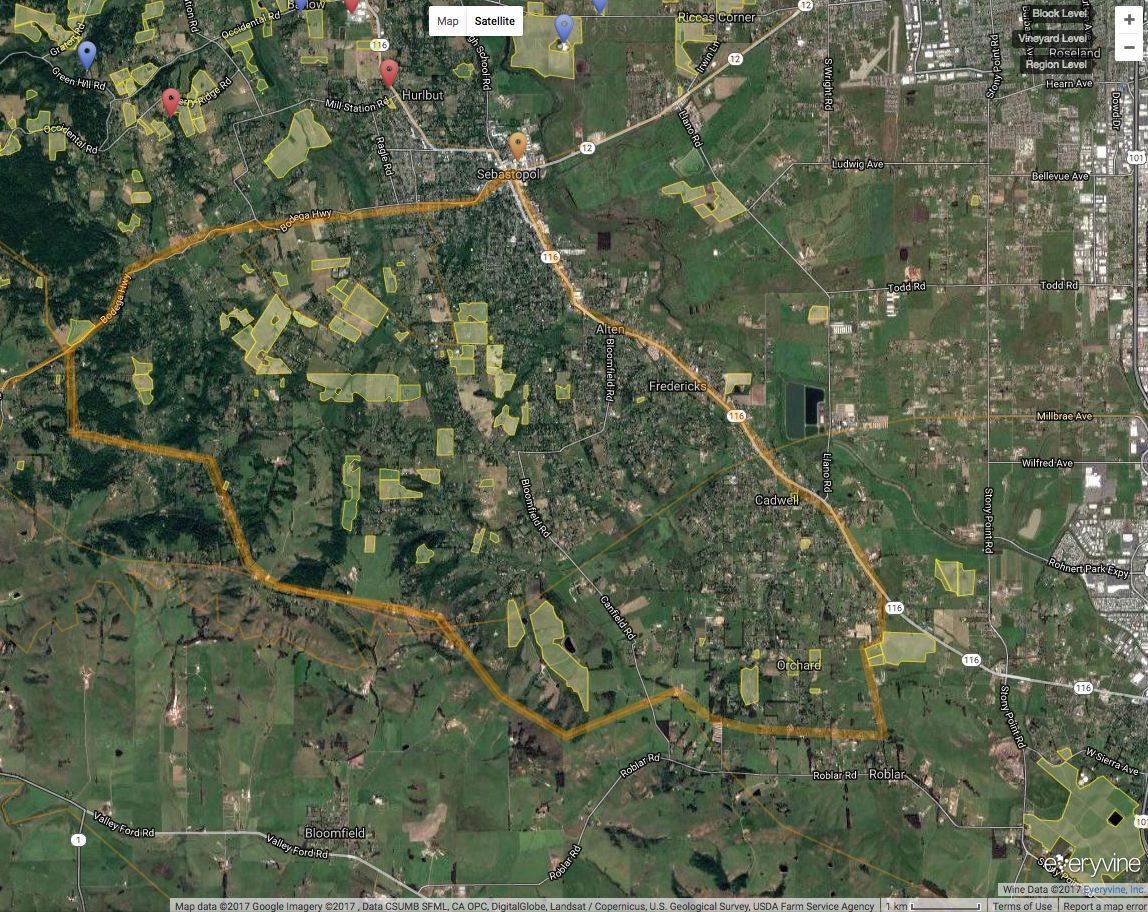
Initially grapes from the Sebastopol Hills were used in blends. Haeger said that the first commercial wine
fashioned primarily from Sebastopol grapes was the 1998 Flowers Sonoma Coast Cuvee, made from grapes
primarily from a Pratt Vineyard. A year later, winemaker Fred Scherrer bought Halleck’s first commercially
viable crop, blended with with lots from Hirsch Vineyard, and crafted a Sonoma Coast blend. Vineyard-designated
Pinot Noirs soon followed. Some of Ted Klopp’s first harvests at Thorn Ridge went to Scott Rich,
who made vineyard-designated Pinot Noirs under his Talisman label. In 2002, the Hallecks launched their
eponymous label, with wines first produced by Greg La Follette and later Rick Davis. The DuNahs followed in
2003 with their first estate grown DuNah Vineyard Pinot Noir, and Balletto made its first vineyard-designated
Pinot Noir from Sebastopol Hills fruit in 2007.
The Sebastopol Hills is actually part of both the Russian River Valley and Sonoma Coast appellations with a
few vineyards also in the Green Valley appellations (see map below). Sebastopol Hills is often referred to as
part of the West Sonoma Coast that is not a true appellation but a marketing designation of the West Sonoma
Coast Vintners. When the proposed Petaluma Gap appellation is approved, the more southern plantings will be
in this appellation as well. Wineries bottling wines from the Sebastopol Hills do not put this sub region on the
front labels since Sebastopol Hills is not an appellation, and use a Russian River Valley or Sonoma Coast
appellation designation. Consumers must find it confusing and need to be well informed to know that a
vineyard-designated Pinot Noir originated from grapes grown in the Sebastopol Hills sub region of the Russian
River Valley. Regrettably, pinotphiles often fail to visit this beautiful area because there is only a few tasting
opportunities among the many vineyards.
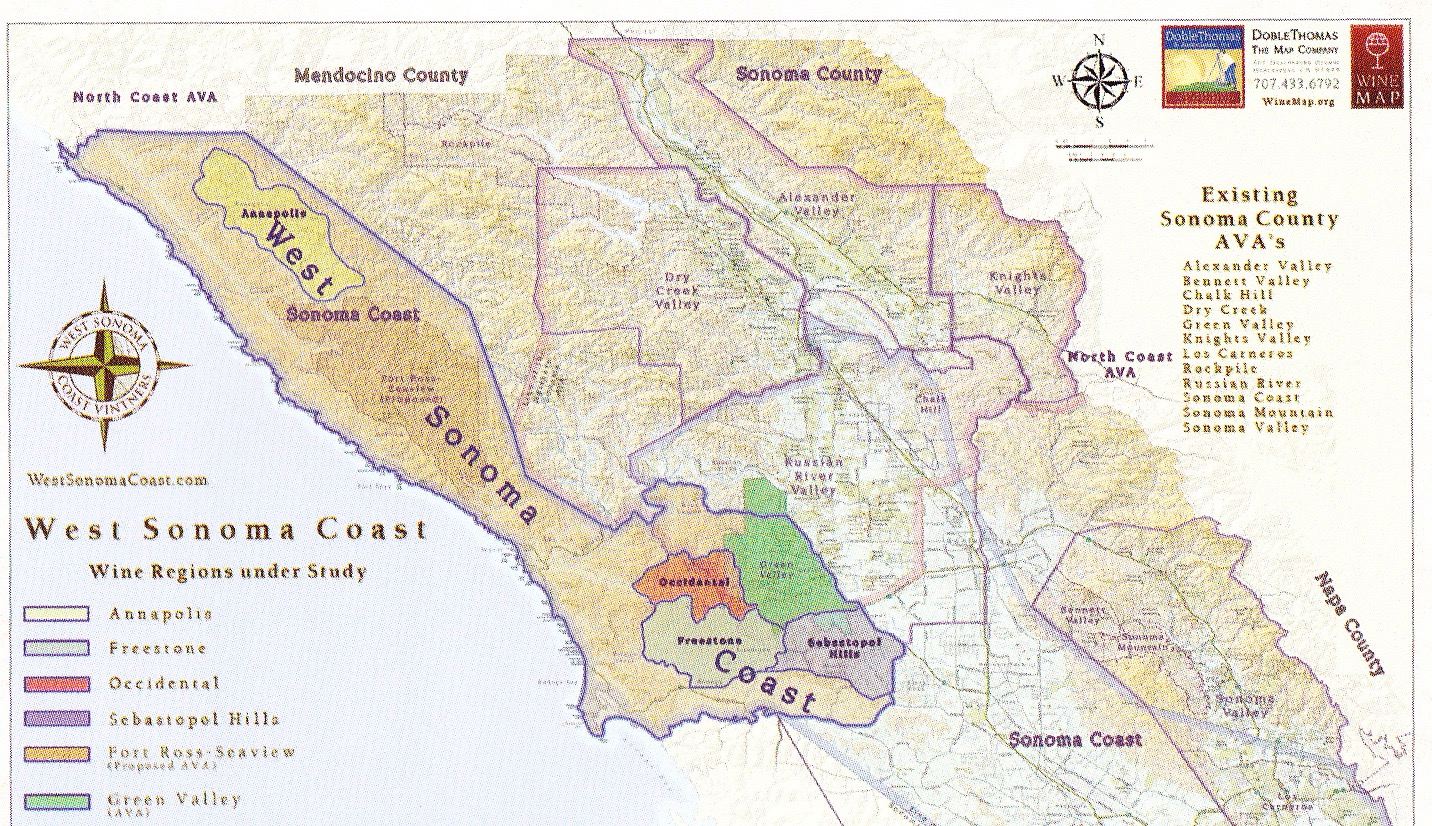
Although the boundaries of the Sebastopol Hills is not defined, according to www.everyvine.com, Sebastopol
Hills makes up only 14,544 acres of the 169,029-acre Russian River Valley appellation. There are 859 planted
vineyard acres among about 52 vineyards - 5.7% of the total Sebastopol Hills acreage. Ted Lemon’s Littorai
estate is the only winemaking facility in the sub region. Reichwage Winery has a winery facility in construction in 2017 adjacent Twin Hills Vineyard (a supplier of grapes to Peay Vineyards and Littorai). Elevations range from 118 to 646 feet with an average
of 360 feet. Ground water availability is generally good.
Sebastopol Hills is the coolest region of the Russian River Valley, with gently rolling hills exposed to heavy
summer fog intrusions from the adjacent Petaluma Gap, particularly the more southern grape plantings and
those vineyards at lower elevations. Mid day heat is tempered by winds from the Petaluma Gap and evening
and early mornings remain a little warmer than other nearby vineyards in the Russian River Valley. This sub
region has 2707 growing degree days with temperatures ranging from 48F to 77.3F with a median of 62.6ºF.
The moderate peak temperatures ensure good acidity in the wines. Annual rainfall is 43.1 inches with 6.03
inches during the growing season.
The soils are generally Goldridge sandy loam, a unique soil type not unique to the Sebastopol Hills but very
prevalent as it is in the adjacent Green Valley. It is derived from the remains of an ancient inland sea that slowly
emptied into the Pacific Ocean three to five million years ago.Ted Lemon of Littorai told me, “There is virtually
no rock in Gold Ridge loam. Only the parent material, the Wilson Grove formation, that is, sandstones, might
where sufficiently compressed by considered ‘rock.’ In winter, Gold Ridge is highly permeable and easily
worked. The clay content of the subsoil can hold moisture for a long time. In summer, Gold Ridge soil basically
turns to concrete unless you cultivate it and in that case it turns into a very fine powder. With some attention
and care, it is a wonderful soil for dry farming grapes.” The Goldridge soil has low fertility allowing grapes to be farmed initially in a low vigor milieu and adjusted as necessary with water and nutrition to achieve superb Pinot Noir quality.
The sensory characteristics of Pinot Noir from the Sebastopol Hills are not well defined. Winemakers have
pointed out a few generalizations: ripe phenolics at relatively low Brix, good natural acidity, fine-grain tannins,
typically earth, minerality and savory characters dominate, darker fruits are the rule, warm spice (nutmeg,
clove) and floral notes common.
Notable wineries that either grow or have sourced grapes from vineyards in the Sebastopol Hills include Anthill
Farms, A.P. Vin, Balletto, Banshee Wines, Bailiwick, Boheme, C. Donnatello, Capiaux Cellars, Cattleya,
Chasseur, COBB, De Loach, Dutton-Goldfield, Eric Kent, Ernest Vineyards, Failla, Freeman Vineyard &
Winery, Halleck Vineyard, Hartford Court, Inman Family, J Vineyards & Winery, Jigar, Kanzler, Kosta Brown, La
Follette Wines, La Pitchoune, Landmark, LaRue, Littorai, Lynmar, MacPhail, MacRostie, Merry Edwards, Pali
Wine Co., Papapietro Perry, Patz & Hall, Peay Vineyards, Pellegrini, Rhys, Rivers-Marie, Siduri, Soliste, Spell Estate, Suacci
Carciere, Talisman, Vaughn Duffy, Von Holt, W.H. Smith, Withers, and Zepaltas.
I recently visited three wineries either located in the Sebastopol Hills (Halleck Vineyard and Kanzler Vineyards)
or have significant vineyard holdings in the Sebastopol Hills (Balletto Vineyards). Here is background
information on each winery and the results of my tastings.
Balletto Vineyards
John Balletto is a man of the earth, a farmer with a firm handshake and an endearing personality. He started
farming vegetables in Sonoma County at the age of 17 in 1977 following the untimely death of his father from
cancer. John started with $200 and 4 acres of land surrounding the family home. Along with his spouse Terri,
he grew the family vegetable farming business into the largest in Northern California at its peak (over 700
acres). However, a number of factors played out including disastrous El Nino weather events that eventually
made vegetable farming in Sonoma County unprofitable and John successfully transitioned to wine grape
growing beginning in 1995. It is a remarkable story of fortitude that could make for an inspirational tale on its
own.
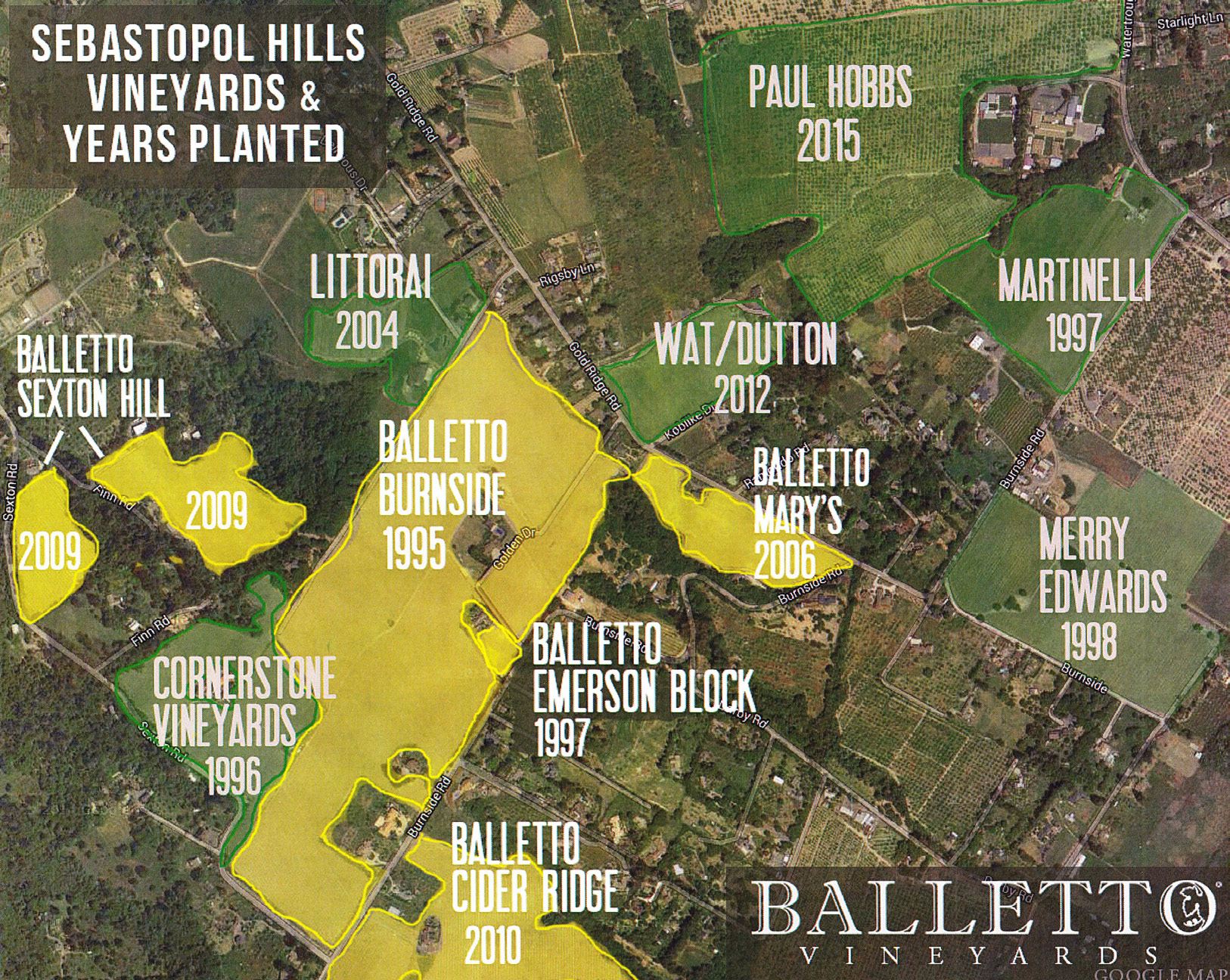
With the assistance of Cecile DeLoach, he planted Pinot Noir, Pinot Gris and Chardonnay in 1995 in the Santa
Rosa Plain and expanded his plantings over the subsequent years. Today, the Balletto family has 700 vineyard
acres spread over 18 different ranches in the Russian River Valley including 280 acres in western Sebastopol.
More than 20 different clones of Pinot Noir are planted.The map above shows Balletto Estate vineyards in the
Sebastopol Hills sub region of the Russian River Valley.
Balletto Vineyards is located at 5700 Occidental Road in Santa Rosa, a property that shares its western edges
with the Laguna de Santa Rosa wetland habitat that is preserved lands. The first Balletto Vineyards wines were
released in 2001 (1,000 cases), produced at the site of the current winery that had been converted from the
vegetable farm’s produce packaging and shipping building with its ideal 12-inch-thick walls. Today, Balletto
Vineyards is one of the few 100 percent estate grown and bottled producers in the Russian River Valley.
Winemaker Anthony Beckman started at Belletto Vineyards as an enologist in 2007 and was promoted to
winemaker two years later. His adept winemaking has pushed the quality of Balletto wines and many
accolades have been forthcoming from wine competitions, wine critics and the wine press.
Most of the grapes from the Balletto vineyards is sold to renowned Sonoma County winemakers, with the top
10 percent of the fruit reserved for Balletto Vineyards’ bottlings. Annual case production of Pinot Noir and
Chardonnay has gradually increased over the years along with an expanding portfolio of single-vineyard Pinot
Noir wines from a cluster of sites in the Sebastopol Hills including Burnside Road, Cider Ridge and Sexton Hill,
and the estate BCD Vineyard and Winery Block Vineyard in the Santa Rosa Plain sub region of the Russian
River Valley. Total wine production, including sparkling wine, Pinot Gris, Sauvignon Blanc, Gewürztraminer,
Rose, Syrah and Zinfandel total 20,000 cases. A map of Balletto vineyard sites is below.
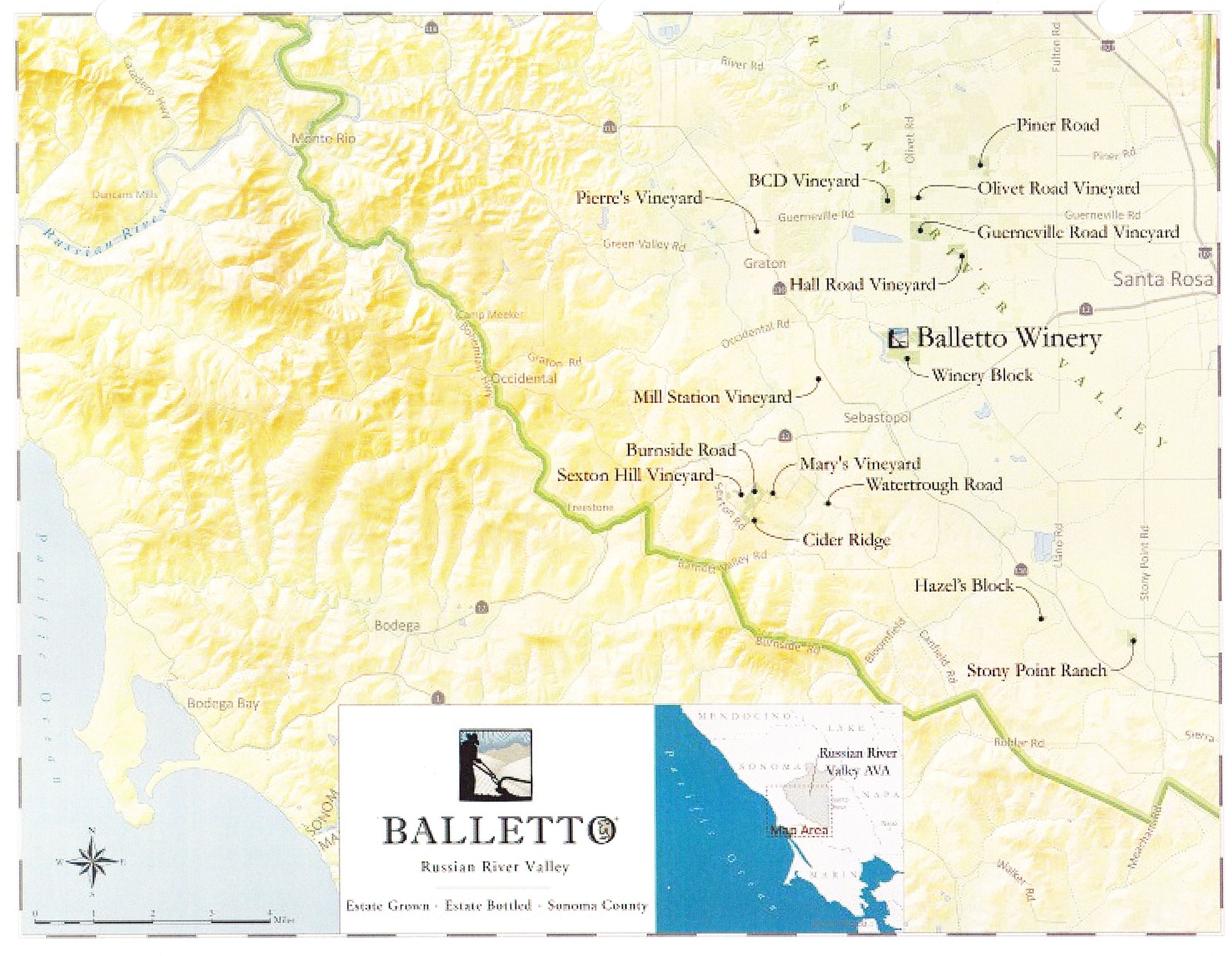
As a testament to the Balletto family’s integrity, more than a dozen employees have worked with John and Terri
Balletto for 20 or more years, and 18 families reside in local housing built and subsidized by the Ballettos. As a
sign of commitment to employees, a regulation-sized “Field of Dreams” baseball field was built at Occidental
Road Vineyard at the request of Balletto’s vineyard workers as a place they could play and practice.
In 2010, the Ballettos were awarded the Sonoma County Farm Bureau Family of the Year. Photo below shows
Terri and John Balletto along with daughters Caterina and Jacqueline.
The Balletto Vineyards tasting room is open daily from 10:00 a.m. to 5:00 p.m.. The sensibly priced wines are
also distributed to fine retailers and sold on the website at www.ballettovineyards.com. The 2012 sparkling wine
and 2016 rose are currently available while the 2015 Pinot Noirs are fall 2017 releases with the BCD and
Sexton Hill in pre-release. Eight Pinot Noirs are currently produced: 5 vineyard designates, an 18 Barrel
reserve, an Estate bottling and a Russian River Valley blend.
I recently visited the winery and tasted with owner John Balletto and winemaker Anthony Beckman.
2016 Balletto Vineyards Russian River Valley Rosé of Pinot Noir See review in article on Rosé wines later
in this issue. 92.

2015 Balletto Vineyards Russian River Valley Pinot Noir
14.1% alc., 3,200 cases, pH 3.63, TA
0.59, $29. The winery’s flagship wine and a consistent Gold Medal winner. In 2015, some vineyards
contributing to this wine yielded less than 1 ton per acre. Aged in French oak barrels, 32% new.
·
Moderate garnet color in the glass. The nose leads with aromas of Bing cherry, rhubarb and spice.
Cherry flavor driven, this mid weight wine is easy going with modest tannins, a compliment of oak in
the background and noticeable black cherry goodness on the finish.
Score: 89-90
2015 Balletto Vineyards Winery Block Russian River Valley Pinot Noir
First produced in 2007, this wine is
sourced from a special block adjacent the winery that stands out.
·
Moderately dark garnet color in the glass.
Exuberant aromas of dark strawberry, cherry and mocha are inviting. A lovely wine in the mouth, with
noticeable dark berry fruits that impress on entry, mid palate and finish. Fine-grain fruit tannins provide support
and juicy acidity stokes the bright and persistent finish.
Score: 92-93
2015 Balletto Sexton Hill Vineyard Russian River Valley Pinot Noir
$44.
·
Moderate reddish purple color in
the glass. Enticing aromas of dark red fruits, rose petal and spice. Middleweight in style, with fruit flavors of
black raspberry and black cherry framed but structured fruit tannins that support rather than impose. Nicely
balanced with an intensely fruity finish that leaves a smile.
Score: 92-93
2015 Balletto Sexton Hill Vineyard Russian River Valley Pinot Noir
13.5% alc., pH 3.60, TA 0.59, 500
cases, $44. Indigenous yeast fermentation, aged in French oak barrels, 38% new.
·
Moderate garnet color in the
glass. Aromas of purple grape, raspberry coulis lead off. Sleek and juicy, with flavors of oak-kissed black
raspberry, boysenberry and ollaliberry. Reserved tannins, welcome acidity, and a pleasing but not intense
finish.
Score: 92
Balletto Vineyards wines tasted in my usual extensive fashion at my home office after my winery visit.
2015 Balletto Burnside Road Vineyard Russian River Valley Pinot Noir
13.7% alc., pH 3.59, TA 0.59, 580
cases. Indigenous yeast fermentation in six-ton open top fermenters, aged in French oak barrels, 33% new.
·
Moderate garnet color in the glass. Deep aromas of cherry and allspice. Quite charming in the mouth, with a
mid weight, juicy core of earth-kissed black cherry fruit. Polished, with firm tannins and some finishing length.
Quite typical of the Sebastopol Hills.
Score: 92
2015 Balletto Burnside Road Emerson Block Russian River Valley Pinot Noir
13.7% alc., 140 cases.
·
Moderate garnet color in the glass.
The nose is very charming, featuring aromas of black cherry, spice,
tobacco smoke, dark chocolate and floral goodness. Mid weight plus in
style, offering a haunting core of black cherry fruit with a minerality that is
quite apparent. Firm tannins make for a slightly brutish wine, but in a
good way.
Score: 93
2015 Balletto Winery Block Russian River Valley Pinot Noir
13.9% alc., pH 3.51, TA 0.60, 575 cases.
Indigenous yeast fermentation and aged in French oak barrels, 33% new.
·
Moderately dark garnet color in the
glass. Inviting aromas of dark red and purple fruits, spice and earthy flora segue into a mid weight plus styled
wine with vivid flavors of purple berries. Very seductive velveteen mouthfeel, perfectly ripened fruit, and an
intensely fruited finish with a good cut of acidity.
Score: 93
2015 Balletto BCD Vineyard Russian River Valley Pinot Noir
14.0% alc., pH 3.64, TA 0.57, $44. Indigenous
yeast fermentation and aged in French oak barrels, 40% new.
·
Moderate dark garnet color in the glass. This
wine offers the essence of black cherry, blueberry and pomegranate fruit aromas and flavors accented with a
pleasing hint of oak spice. A satiny texture and admirable harmony add to the enjoyment.
Score: 92

2015 Balletto Cider Ridge Vineyard Russian River Valley Pinot Noir
13.9% alc., pH 3.62, TA 0.58,
590 cases, $42. Double Gold Medal at 2016 Sonoma County Harvest Fair. Vineyard is located 10
miles from the Pacific Ocean in the Sebastopol Hills. Vines are planted primarily to heritage selections
of Pinot Noir. Indigenous yeast fermentation, aged in French oak barrels, 32% new.
·
Moderately dark
garnet color in the glass. The nose draws you in with aromas of dark raspberry, black cherry and pipe
smoke. Mid weight in style, with vivid flavors of blackberry and black raspberry that grab hold of the
mid palate with a vengeance. Satiny in texture with inviting harmony, and a very long, juicy and berry-fueled
finish. You won’t be able to stop at one glass with this beauty.
Score: 94

2015 Balletto Russian River Valley Chardonnay
13.7% alc., pH 3.36, TA 0.67, 1,400 cases, $28.
Barrel fermented and aged, native yeast fermentation, 100% malolactic fermentation. Lees stirring
every three weeks for first six months.
·
Moderate golden yellow color in the glass. A flamboyant wine
with bright flavors of lemon, pineapple, honeysuckle and almond croissant. Very generous flavors of
citrus, white peach, and pear, with well-integrated acidity. This one really aims to please and is a
terrific value.
Score: 92
2014 Balletto Sexton Hill Russian River Valley Chardonnay
14.1% alc., 425 cases, $38.
·
Light golden
yellow color in the glass. An array of aromas great the drinker, including lemon curd, buttery brioche, Asian
pear, waffle and blonde caramel. Nicely composed, with a flavor profile emphasizing apple with added tastes of
lemon, pear and pineapple. Silky in the mouth with admirable balance.
Score: 93

2014 Balletto Cider Ridge Vineyard Russian River Valley Chardonnay
13.1% alc., 475 cases, $38.
Gold Medal 2016 Sonoma County Harvest Fair. This vineyard is located in the Sebastopol Hills and is
sustainably farmed.
·
Moderate golden yellow color in the glass. Pleasing aromas of lemon oil, pineapple
and subtle nutty oak. Soft, sleek and focused, with delightful citrus, white peach, apple, spice and
brown butter flavors. A high-brow wine that is quite charming, leaving behind a thirst-quenching finish
that urges another sip.
Score: 94
Halleck Vineyard
Both Ross and Jennifer Halleck had worked with the wine industry before moving to the Sebastopol Hills of
Sonoma County in 1991. Ross’s marketing agency, Halleck Design Group, was founded in 1980, and assisted
the Silicon Valley high tech industry as well as the Northern California wine industry.
The Hallecks planted their backyard 1-acre vineyard to Pinot Noir in 1994 with the intention of setting aside
profits from the vineyard for their three sons college educations. Planted to Dijon clones 115, 667 and 777, the
vineyard was first harvested for a commercial wine in 1999.
Pinot Noir offerings under the Halleck Vineyard label were expanded in the ensuing years, produced from
excellent vineyards in the nearby Sebastopol area within three miles and vinified by veteran winemaker Rick
Davis. In the 2014 vintage, a unique Pinot Noir was offered from Napa Valley’s Kuleto Estate Vineyard, the only
Pinot Noir currently produced in the Russian River Valley from Napa Valley fruit. Noted restaurateur, Pat
Kuleto, is a big fan of Halleck Vineyard Pinot Noir.
The Halleck Vineyard wines are in such low production that they are not offered at public tastings and the
mailing list to join the Inner Circle Wine Club is currently full. That said, many of the wines can be sampled and
purchased by appointment - book online at www.halleckvineyard.com - with personal tastings paired with local
artisan foods conducted by Ross in his art-filled home adjacent Halleck Vineyard that commands sweeping
views of Sonoma County (plan ahead as appointments are in great demand). Lodging is also available at this
idyllic setting that can be booked through Airbnb.
The winery’s current releases include 2014 Hillside Cuvee Sonoma Coast Pinot Noir, 2014 Three Sons Cuvée
Russian River Valley Pinot Noir, 2014 Clone 828 Sonoma Coast Pinot Noir, 2013 Estate Grown Sonoma Coast
Pinot Noir, 2015 Little Sister Russian River Valley Sauvignon Blanc, and 2016 Russian River Valley Dry
Gewürztraminer. A few library wines are available for sale on the website.
20% of production is sent to the finest restaurants in San Francisco (Farallon, Boulevard) and New York
(Eleven Madison Avenue, Gramercy Tavern).
Education is a central theme of the Halleck's philanthropy and they have raised over $350,000 over the past
dozen years toward education through special winery events. Ross is currently collaborating with noted music
artist Josh Groban, who is a fan of Halleck Vineyard Pinot Noir, in the production of a Pinot Noir, with all profits
going to Groban's Find Your Light Foundation founded in 2011 and dedicated to enriching the lives of young
people through arts, education and cultural awareness.
2013 Halleck Vineyard The Farm Vineyards Russian River Valley Pinot Noir
159 cases, $75. Sourced
from a 2-acre vineyard in the Laguna flats that is organically farmed.
·
Moderately light ruby red color in the
glass. Alluring aromas of rose petal, foliage, tobacco and sage. Discreetly concentrated in an elegant style with
dark fruit flavors, warm spice notes, savory touches, and some finishing length.
Score: 91-92

2013 Halleck Vineyard Clone 828 Sonoma Coast Pinot Noir
14.2% alc., $65. Sourced from a
vineyard located less than a mile from Halleck Estate Vineyard on Burnside Road.
·
Moderately light
ruby red color in the glass. Gorgeous perfume of cherry, spice and dried rose petal. Light to mid weight
in style with a bright backbone of acidity. Impressive red fruit intensity considering the wine’s lighter
demeanor. Tight and focused, with soft tannins and a clean finish.
Score: 93-94
2014 Halleck Vineyard Hillside Cuvée Sonoma Coast Pinot Noir
414 cases, $59.
·
Moderately light
ruby red color in the glass. Woodsy aromas dominant along with scents of red cherry and cranberry. Mid weight
plus array of red and blue fruit flavors with an accent of warm spices and a definite minerality tone. Sinewy,
fine-grain tannins and good follow through on the welcoming finish.
Score: 92-93

2013 Halleck Vineyard Estate Grown Sonoma Coast Pinot Noir
14.5% alc., $110. Tasted from a
bottle that had been opened one to weeks prior and kept under Coravin and tasted from a freshly
opened bottle sampled with Coravin.
·
The previously opened bottle was highly aromatic with soaring
scents of red fruits and spice. On the palate, it resembled a previously opened wine. The newly
opened bottle had a primary nose with a brighter, fresher fruit palate. In either case, a very impressive,
elegantly-styled wine.
Score: 93-94
2014 Halleck Vineyard Kuleto Cuvée Napa Valley Pinot Noir
67 cases, $62. Primarily a Wine Club offering.
Pinot Noir is planted at 800 to 1,000 feet elevation to an unknown clone of Pinot Noir on Kuleto’s 761 acres of
rugged terrain in the mountains of Eastern Napa Valley. Planting began in 1993. Bill Foley purchased Kuleto in
2009. This wine includes some Halleck Vineyard fruit but the 2015 vintage will be 100% Kuleto fruit.
·
Moderately
light ruby red color in the glass. Aromas of fertile earth, mushroom and tutti-fruiti lead to a well-structured, mid
weight offering featuring flavors of purple grape and black raspberry in a unique, rather rustic, earthy and
savory style. I only had a rather brief encounter with this wine so I did not score it. Not surprisingly, it is a
completely different wine as far as aromatics and flavors than the other Halleck Vineyard Pinot Noir offerings,
but crafted in the Halleck Vineyard style.
Score: NS
Kanzler Family Vineyards
Kanzler Vineyards is a family affair that began with the establishment of a Pinot Noir vineyard in the Sebastopol
Hills in 1996. The Kanzlers moved to the area in 1994 in hopes of raising their two children in the country. The
property was the site of a very old, barely-producing apple orchard. In order to make better use of the land, the
Kanzlers explored the possibility of planting wine grapes. In the early 1990s, many winegrowers thought the
Sebastopol Hills was too cold and windy for vineyards. The Kanzlers turned out to be lucky wine grape farmers
after consulting with a next door neighbor, Perry Kozlowski of Kozlowski Farms, whose family had grown
berries and apples in Sonoma County since 1949. Perry told them to grow premium wine grapes.
Sonoma County Viticulture Advisor Rhonda Smith of the University of California at Davis also felt the area had
potential for growing Pinot Noir. Steve then immersed himself in the study of viticulture and took classes at
University of California at Davis and Santa Rosa Junior College. After contacting vineyard manager Eric Neil,
the 14.5-acre Kanzler Vineyard was planted in the spring of 1996.
The vineyard is planted in Goldridge sandy loam on Wilson Grove formation. Pinot Noir clones 115, 667 and
Pommard 4 are planted on 101-14, 1103P and 420A rootstocks. The vines are vertical shoot positioned and
cane pruned.
After the first harvest in 2000, grapes were sold to well-known wineries including Landmark Vineyards, Flowers
Vineyard and Winery and Gary Farrell Vineyards and Winery. Little-known Kosta Browne realized the quality of
the grapes and made a Kanzler Vineyard designated Pinot Noir every year since 2002. The 2004 Kosta
Browne Kanzler Vineyard Pinot Noir was awarded a score of 98 points and both Kosta Browne and Kanzler
Vineyards became well known to the Pinot Noir cognoscenti. As Kanzler Vineyards own wine production has
grown, less grapes are sold to others but Kosta Browne and Lynmar Estate continue to receive an allocation.
The first successful wine made by Stephen and Landmark winemaker Greg Stach from the 2002 vintage was
served to the 200 guests at daughter Melissa Kanzler’s wedding. The wine was so well received, it was
decided to produce Pinot Noir under the Kanzler Vineyards label. In 2004, they used four tons of fruit from the
vineyard and crafted the first 250 cases of commercial Kanzler Vineyards Pinot Noir.
The winery is now in the hands of the second generation, Alex Kanzler. He was ten years old when the
vineyard was planted and grew up working as a field hand. After college he pursued winemaking from Sonoma
to New Zealand to Oregon and back to Sonoma. In 2011, he became the winemaker and in 2014 focused
entirely on Kanzler Family Vineyards. Alex’s spouse, Breauna, handles consumer sales. The harvest photo
below is of Alex and Breauna Kanzler flanked by Stephen Kanzler and his current spouse.
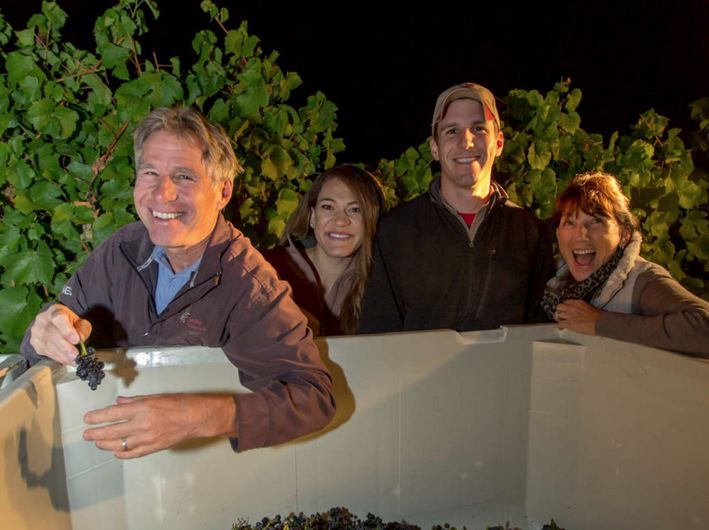
Current production is 3,500 to 5,000 cases annually from the Estate Vineyard and other vineyard sources.
Walker Station Vineyard, located southwest of Forestville in the Russian River Valley is now leased by Kanzler
Vineyards and is a reliable source of Pinot Noir and Chardonnay. Fruit is also sourced from other small, familyowned
vineyards in the area including Lolita Ranch, Mes Filles Vineyard and Umino Vineyard. A Russian River
Valley Rose and Walker Station Chardonnay have been added to the Pinot Noir lineup that includes the
Kanzler Russian River Valley and Kanzler Estate Reserve bottlings.
The wines are primarily available to members of the winery’s mailing list at www.kanzlervineyards.com. Labels
have been updated and are designated Russian River Valley rather than Sonoma Coast beginning with the
2015 vintage since consumers can more readily identify with this winery’s location in the Sebastopol Hills sub
region of the Russian River Valley. The winery’s label evolution:
When I visited recently, I sat down with Alex Kanzler to taste a vertical of Kanzler Vineyards Estate Reserve
Pinot Noirs. All Kanzler Vineyards wines are crafted using the same techniques and no wine is predestined or
precluded from inclusion in the Estate Reserve bottling. The only requirement is that it must be grown on
Kanzler’s 20-acre ranch. The Estate Reserve wine is a barrel selection capturing the feel of the vintage.
Typically, the Reserve Pinot Noirs are aged in 40%-50% new French oak barrels and the Russian River Valley
Pinot Noir is raised in 25%-30% new French oak barrels. The wines in this vertical tasting show a common
thread, but each vintage is distinctly different.
Tasting is available by appointment at Kanzler Vineyards. Visit www.kanzlervineyards.com.
2010 Kanzler Vineyards Estate Reserve Sonoma Coast Pinot Noir
14.7% alc.. The first wine blended by
Alex Kanzler. Only 15 barrels in this vintage and 75 cases of the Reserve wine. A healthy amount of whole
cluster was included in the fermentation.
·
Moderate garnet color in the glass. Very nicely perfumed with whole
cluster nuances of exotic spices, burnt tobacco and rose petal. Modest in weight with soft tannins, featuring
flavors of dark red fruits, spice, savory herbs and oak char in the background. This wine has aged beautifully.
Score: 91-92

2011 Kanzler Vineyards Estate Reserve Sonoma Coast Pinot Noir
14.1% alc.. Some whole
cluster inclusion, clone 115 driven.
·
This wine is gorgeous with plenty of Pinot singing. Uplifting aromas
of cherry, blueberry and spice. A warm spice thread pervades the flavor profile. The silky, fine-grain
tannins caress the palate and the finish is fresh and generous. A remarkable wine from a challenging
vintage.
Score: 93-94
2012 Kanzler Vineyards Estate Reserve Sonoma Coast Pinot Noir
14.8% alc.. Less whole cluster inclusion
than in 2011.
·
Moderate garnet color in the glass. Interesting aromas that include smoky cherry, incense, white
pepper and a slight vegetal note. A slightly smoky char note pairs with mid weight blueberry and black cherry
fruit flavors with added accents of dried herbs and warm spices. Nicely balanced, with silky tannins and a
modest, but pleasing finish.
Score: 91-92
2013 Kanzler Vineyards Estate Reserve Sonoma Coast Pinot Noir
14.6% alc.. More Pommard clone
included in this vintage.
·
Moderate garnet color in the glass. The nose has much appeal, sporting aromas of
black cherry, exotic Asian spices, and floral perfume. More richness and sappy intensity in this vintage. Broad
and fruit driven on the palate featuring flavors of dark red and black fruits along with anise and tobacco notes.
Broad and soft in the mouth, with suave, sandy tannins, and a finish of some note.
Score: 92-93

2014 Kanzler Vineyards Estate Reserve Sonoma Coast Pinot Noir
14.4% alc., 225 cases, $78
(sold out). Good percentage of whole cluster in this wine and a significant proportion of Dijon clone 115
(55%) along with Dijon clone 667 and Pommard clone. Three barrels of 115 clone were fermented with
25% whole cluster inclusion.
·
Moderate garnet color in the glass. Similar in aromatic profile to the 2013
vintage with scents of cherry, spice and floral bouquet. Impressive attack of black cherry fruit that
expands in the mouth. Juicy, with some textural interest, subtle oak in the background, and a very long
finish featuring gorgeous black cherry fruit. The balance is impeccable. Will only improve with further
time in the cellar.
Score: 93-94
2015 Kanzler Vineyards Russian River Valley Pinot Noir
481 cases, $56. Some Walker Station grapes
along with Estate vineyard grapes. Very modest whole cluster inclusion (5%). 3 to 5-day cold soak, fermented
with native yeast or inoculated commercial yeast in plastic bins or stainless steel fermentation tanks. Basket
pressed and aged 14 months on the lees in French oak barrels, 50% new. Bottled unfined and unfiltered.
·
Moderate garnet color in the glass. Shy aromas of black cherry and warm spices lead to a mid weight style
offering flavors of black cherry, black raspberry and blackberry. Very modest tannins and bright acidity. Enters
better than it finishes but highly enjoyable. Could use a little more time in bottle.
Score: 90-91